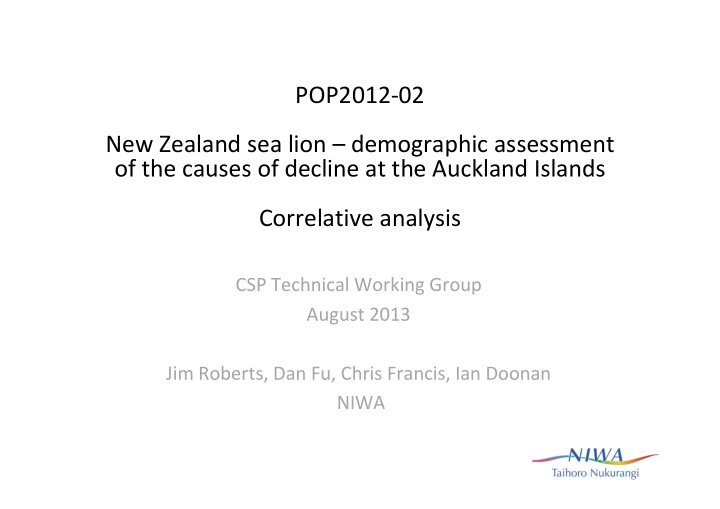



POP2012-02 New Zealand sea lion – demographic assessment of the causes of decline at the Auckland Islands Correlative analysis CSP Technical Working Group August 2013 Jim Roberts, Dan Fu, Chris Francis, Ian Doonan NIWA
Phase II Correlative analysis What are the demographic drivers of population decline? (candidate proximate cause) • Variation in juvenile survival may be sufficient to explain observed decline in pup production Long term shifts in pup survival to age1 – not just stochastic variation • Individual years of low pupping probability and adult survival • Variation in age at first pupping What are the ultimate causes of population decline? (some candidates) • Relationships between juvenile survival, maturation or breeding rates and biological/environmental correlates or disease events • How does the survival of vulnerable age classes relate to estimates of fishery-related mortalities?
Variation in pup mass Pup mass at Sandy Bay from 1995-2013 • Decline in difference in male & female • pup mass Correlation with pup survival estimates •
Ocean climate Negative correlation • between ENSO & SST Increased SST post 1998 • El Nino (also SSH) Increased primary • production during mid- 2000s
GAM/GLM modelling prey sp. CPUE gam ( catch ) ~ β + year + month + vessel + s( depth ) + s( latitude , longitude ) + s( duration ) + s( mid-time ) glm ( pres/abs ) ~ β + year + month + vessel + depth + latitude * longitude + duration + mid-time Shifts in abundance • (CPUE!) of common prey sp. Occurrence of • some high-energy prey intermittent (BAR) or temporary (JMM)
Some early output from phase II 1. Reduced pup survival & male-female pup mass during period of declining pup counts – indicates food limitation? 2. Pup mass a proxy for Surv0+Surv1 of a cohort? 3. Long-term shifts in prey abundance, including abundant and high energy species 4. Positive correlations tween fishery CPUE and diet Future work Two-day workshop planned in December 2013
References Childerhouse, S. J., Dawson, S. M., Slooten, E., Fletcher, D. J., Wilkinson, I. S. (2010). Age distribution of lactating New Zealand sea lions: Interannual and intersite variation. Marine Mammal Science , 26 : 123-139. Gilbert, D.J., Chilvers B.L. (2008). Final report on New Zealand sea lion pupping rate. POP2006-01. Objective 3. Analysis from sea lion database to estimate pupping rate and associated parameters. MacKenzie, D.I. (2012). Estimation of Demographic Parameters for New Zealand Sea Lions Breeding on the Auckland Islands - Final Report: 1997/98- 2010/11. Objective 3: POP2010/1
Recommend
More recommend